[Updated March 28, 2018]
When Emma, a German Shepherd mix with magnificent, mule deer ears, jumps out of the car after being driven home from a particularly hard run on the trails or mucky outing at the beach, she immediately trots into the bathroom and waits for her bath. During her soaping and rinsing, her owner sings and tells her stories. Cheeky squirrels are given a run for their money by fleet, wily dogs. Cats are put firmly in their place by commanding, resourceful dogs, and humans are rescued from various perils by brave and sagacious dogs (all the dogs bear a striking resemblance to Emma, of course).
After an initial toweling and shake, Emma is wrapped in a warm cotton flannel blanket and snuggles under the bedclothes to take a long nap. When she awakens, refreshed and sweet- smelling, she is brushed, extravagantly praised and given a special treat.
For Emma, life – and being groomed – is a very good thing. Grooming Emma is also a pleasure for Emma’s owner: An intimate interlude in a hectic day spent caring for and paying attention to someone dear to her heart. They’ve worked out their ritual to their own satisfaction and they both love it.
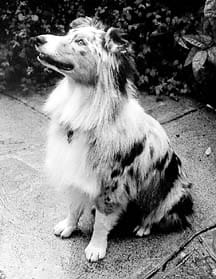
From toenails to teeth to tail, grooming is an intimate, personal issue. We groom our dogs for their health and cleanliness and the satisfaction of seeing them look their best.
However, “best” is a relative term and whatever it means to you, it can be difficult to achieve when something is amiss in the canine/human relationship. Precisely because grooming is such an intimate act, the process can invoke physical pain (an aching back, for instance), as well as feelings of impatience, frustration, and guilt in both groomer and groomee!
Exacerbating Your Dog’s Grooming Issues
Grooming your dog when you’re disgruntled, or procrastinating and avoiding the issue, are both like abusing credit cards: you may get what you want now, but you can’t avoid having to pay the bill – with interest -later. Your dog pays with a reduction in her health and an increase in her stress and discomfort. You pay with time and money spent at the groomer’s or veterinarian’s office. Your relationship with your dog also suffers from a breach of trust.
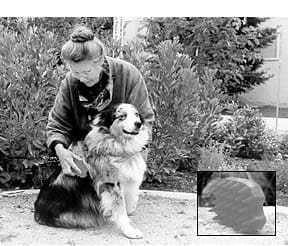
Your dog also has her own perceptions and feelings about being groomed. One dog may balk and back away from the bathroom door. Another may gouge the floor during her great escape from a nail trim. A third may tremble in tune with an aspen leaf at the sight of a flea comb.
Attempts to groom under these circumstances can not only exacerbate a problem, but set up a mutually damaging cycle: the more she resists, the more you’ll dislike grooming her. The more you shirk this duty, the more likely she’ll develop some of the very conditions grooming helps to prevent. The primary reasons for grooming your dog are health and cleanliness. Skin conditions, lumps, and injuries can be noticed and treated (by you, or when appropriate, by a veterinarian) before they become serious.
Procrastinating or neglecting to groom your dog can cause skin problems and pain from dirty and matted fur, gait problems and joint stress from over-long toenails, hearing loss from clogged or damaged ears, local and systemic infections from gingivitis, and any number of health problems from undetected and untreated flea and tick infestations.
Set Your Dog’s Mood with Positive Vibrations
Fortunately, you and your dog can break the cycle and get back in harmony by working to change each other’s perceptions about grooming. As the groomer, you are responsible for your dog’s experience. In order to bring about a more perfect union of trust, harmony and balance, you need to take the first step. Start by remembering when you and your dog shared a wonderful moment of complete trust, companionship, and harmony. Now try to maintain that feeling while you imagine grooming your dog. It may seem impossible to have those feelings during a grooming session, but read on! It’s not just possible, but it can even be fun!
Always Touch Your Dog with Love
More than anything else we do with and to our dogs, grooming is based on touch. It’s impossible to accomplish any of it without touching your dog, whether it’s toenail trimming or tooth-brushing, flea combing or untangling matted fur, a quick lick and a promise or a laborious show ‘do. No matter how you define it, feel about it or do it, grooming is a non-verbal form of communication that is transmitted through touch.
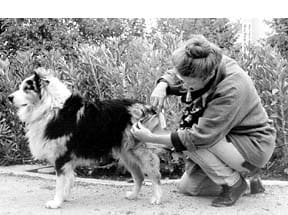
Helen Keller expressed this wonderfully: “I have just touched my dog. He was rolling on the grass with pleasure in every muscle and limb. I wanted to catch a picture of him in my fingers, and I touched him as lightly as I would a cobweb . . . he pressed close to me, as if he were fain to crowd himself into my hand . . . if he could speak, I believe he would say with me that paradise is attained by touch, for in touch is all love and intelligence.”
To groom your dog with the touch of love and intelligence, to “catch a picture” of her in your fingers through touch – that is communication. What you say and do with her and how you “listen” to what she’s saying and doing creates a feedback loop that results in an ever-more-meaningful and expansive conversation that replaces the old cycle of irritation, pain, and mistrust. Being willing to change our attitudes and approaches to grooming, and to help our dogs become cooperative participants, is a great start toward creating a rewarding ritual rather than a habitual pattern of balk/pull, whine/admonish, cower/encourage, yay/whew!
This is where techniques such as TTouch can be most helpful. If the theorists about the body/mind connection are right (and recent discoveries in neurology and cellular biology indicate they are), the body remembers everything that happens to it. TTouch works directly on the nervous system to help you to discover the response patterns stored in your dog’s (and your) body and bring them to the brain’s attention. When the brain can perceive a more efficient way to function, it makes every effort to implement it. Improvements in health and behavior can be rapid and permanent. The dog’s ability to think and focus is increased.
Bringing awareness to how your dog (and you) hides or expresses responses is an opportunity for you to interrupt habitual, negative patterns and point the way to new, more positive ones. This helps change how the body feels about itself and, along with relief from fear, tension, and stress, it creates a better self-image and boosts self-esteem. The benefits are reciprocal and balance is achieved.
Creating these new feelings, added to your new perceptions, will profoundly change the way you communicate with your dog. The term “handling” will take on a whole new meaning. Your relationship will thrive and harmony will be restored. (For more information on how TTouch works and some specific touches, see “TTouch and Noise Phobias,” WDJ May 1999, “Quiet Barking in Your Neighborhood,” WDJ October 1998, and “Acupressure Techniques for Treating Dog Pain,” May 1998.)
Starting Anew
To start anew, pretend you’ve never groomed your dog before. With a note pad and pen, sit down and without side comments or judgments, look at your dog with fresh eyes. What’s her body type? Is she delicate, sturdy, long, lean, short, round, tiny, or huge?
Think about her emotional and physical sensitivity. Is she a shrinking Violet, nervous Nellie, swooning Camille, or the Rock of Gibraltar? Note what kind of coat she has. Is it thick, thin, long, short, fine, coarse, swirly, wavy, or straight?
Remind yourself about how she approaches things. Does she like to have advance notice, be talked through difficulties, mull them over, negotiate, or be bribed? Highlight any special issues. Is she inexperienced, energetic, old, infirm, allergic, disabled, or phobic?
Now imagine her going through the grooming process. Do you anticipate any glitches? Looking over your list of her emotional and physical considerations, can you think of any things you could do to make the process go more smoothly, more pleasurably for her – and for you? With notes in hand and fresh insights in mind, make a grooming plan for your dog.
Evaluate her grooming environment. Think about temperatures, surfaces, sounds, smells, and feelings. Think about her safety and comfort for each stage. Think about where you’re starting and where you want to end up. Put yourself in her place and try the tools and techniques on yourself! Imagine yourself going through a similar process at a spa, as a young child and as an invalid; how would you like to be handled?
Separate each grooming task and then break it down even further. One nail clipped successfully (from her viewpoint) on Monday will give you a big advantage when you go to clip the next one on Tuesday. Small steps now will lead to major accomplishments tomorrow. Not everything has to be done at once. Timing is everything. Choose your time wisely and give yourself plenty of it. Take your dog’s daily routines and your schedule into account. Better a job left undone than one done in a hurry or just before she goes out for her midday dirt roll! Ask yourself whether you have time to complete the task and whether it is reasonable to do so.
Be prepared. Make sure you have everything you need for the job at hand. A check list for each job can be a handy reminder in the beginning. Turn off the phone or at least bring it with you. This is a special time for you and your dog. It’s rude, as well as potentially very messy, to let yourself be distracted by something. Picture a soaped up dog running through the house and you won’t have any trouble staying focused!
Pay attention. Breathe, start slowly, and be fully present. Monitor your dog; if she starts to have a problem, stop as quickly as possible and end with something enjoyable. Use what she likes and is easy for her to help change what she doesn’t like or is difficult for her. “Bracket” things she’s not sure about with very good things before and after. If you make the endings really wonderful (think of Emma), your dog will know what’s coming next and look forward to it.
Separate training or practice from the real thing. Use the word “bath” only when you really mean it. She may act like a clown to distract you or avoid being touched in a sensitive area, but don’t tease, threaten, or laugh at her. You’re both finding your way to a better place, so be patient and explain to her what you’re doing and why. It’s only polite to do so and she may surprise you with her understanding response. Ginger, an Australian Shepherd I know, once surprised her owner this way. When told it was really difficult to reach the mat on the inside of her thigh, Ginger lifted her leg and patiently held it up until the job was done.
Read books and WDJ, watch videos, pick the brains of professional groomers and competent friends, and peruse catalogues for new tools and general information about dogs and grooming. There’s a better grooming mouse trap every day!
Dog Grooming Goals
Finally, use the following three statements as a guide to clarify the grooming experience for you and your dog:
1. I will groom my dog for her health and cleanliness.
2. I will cause her no harm in the process.
3. I will make it as mutually pleasurable as possible.
Explore these statements with mindful awareness and imagination. With this credo and TTouch in hand, your choice of methods, tools, and techniques will become self-evident as an expression of your philosophy, creativity and attitude. When difficulties arise your new perception will lead you to ask questions. Why is this happening? How can I help? You will find new and ingenious solutions.
Each grooming will become easier and more enjoyable. You and your canine companion’s trust in each other will continue to deepen and strengthen. Your dog may never look perfectly groomed, but as Spanish artist Esteban Vicente said, “You must make the effort, for through effort comes joy.” Your dog will display your efforts for all to see. Your feelings of connection and harmony will flourish and be joyful. You will, together, bask in the “look” of love.
Sabra Learned, of Berkeley, CA, is a Certified TTouch Practitioner. She offers private appointments and group classes.


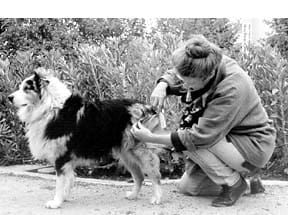


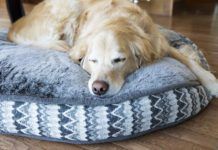

My pet Husky needs to be groomed. I like how you mention to remind yourself that you are grooming your dog for its health. Thank you for the information. I’ll try grooming her by myself and if I need help I’ll contact a dog groomer.